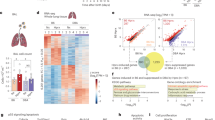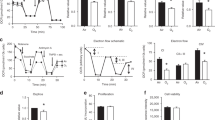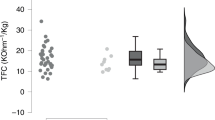Abstract
Background
Preterm infants frequently require oxygen supplementation at birth. However, preterm lung is especially sensible to structural and functional damage caused by oxygen free radicals.
Methods
The adaptive mechanisms implied in the fetal-neonatal transition from a lower to a higher oxygen environment were evaluated in a murine model using a custom-designed oxy-chamber. Pregnant mice were randomly assigned to deliver in 14% (hypoxic preconditioning group) or 21% (normoxic group) oxygen environment. Eight hours after birth FiO2 was increased to 100% for 60 min and then switched to 21% in both groups. A control group remained in 21% oxygen throughout the study.
Results
Mice in the normoxic group exhibited thinning of the alveolar septa, increased cell death, increased vascular damage, and decreased synthesis of pulmonary surfactant. However, lung histology, lamellar bodies microstructure, and surfactant integrity were preserved in the hypoxic preconditioning group after the hyperoxic insult.
Conclusion
Postnatal hyperoxia has detrimental effects on lung structure and function when preceded by normoxia compared to controls. However, postnatal hypoxic preconditioning mitigates lung damage caused by a hyperoxic insult.
Impact
-
Hypoxic preconditioning, implemented shortly after birth mitigates lung damage caused by postnatal supplemental oxygenation.
-
The study introduces an experimental mice model to investigate the effects of hypoxic preconditioning and its effects on lung development. This model enables researchers to delve into the intricate processes involved in postnatal lung maturation.
-
Our findings suggest that hypoxic preconditioning may reduce lung parenchymal damage and increase pulmonary surfactant synthesis in reoxygenation strategies during postnatal care.
This is a preview of subscription content, access via your institution
Access options
Subscribe to this journal
Receive 14 print issues and online access
$259.00 per year
only $18.50 per issue
Buy this article
- Purchase on SpringerLink
- Instant access to full article PDF
Prices may be subject to local taxes which are calculated during checkout






Similar content being viewed by others
Data availability
All data are available in the main text or the supplementary materials.
References
Wyckoff, M. H. et al. Neonatal life support: 2020 international consensus on cardiopulmonary resuscitation and emergency cardiovascular care science with treatment recommendations. Circulation 142, S185–S221 (2020).
Kapadia, V. et al. Outcomes of delivery room resuscitation of bradycardic preterm infants: a retrospective cohort study of randomised trials of high vs low initial oxygen concentration and an individual patient data analysis. Resuscitation 167, 209–217 (2021).
Saugstad, O. D., Lakshminrusimha, S. & Vento, M. Optimizing oxygenation of the extremely premature infant during the first few minutes of life: start low or high? J. Pediatr. 227, 295–299 (2020).
Oei, J. L. et al. Outcomes of oxygen saturation targeting during delivery room stabilisation of preterm infants. Arch. Dis. Child Fetal Neonatal Ed. 103, 446–454 (2018).
Kapadia, V. S. et al. Resuscitation of preterm neonates with limited versus high oxygen strategy. Pediatrics 132, 1488–1496 (2013).
Vento, M. et al. Preterm resuscitation with low oxygen causes less oxidative stress, inflammation, and chronic lung disease. Pediatrics 124, 439–449 (2009).
Sever, N., Miličić, G., Bodnar, N. O., Wu, X. & Rapoport, T. A. Mechanism of lamellar body formation by lung surfactant protein B. Mol. Cell 81, 49–66 (2021).
Hentschel, R., Bohlin, K., van Kaam, A., Fuchs, H. & Danhaive, O. Surfactant replacement therapy: from biological basis to current clinical practice. Pediatr. Res. 88, 176–183 (2020).
Whitsett, J. A. & Weaver, T. E. Hydrophobic surfactant proteins in lung function and disease. N. Engl. J. Med. 347, 2141–2148 (2002).
Sweet, D. G. et al. European Consensus Guidelines on the Management of Respiratory Distress Syndrome: 2022 Update. Neonatology 120, 3–23 (2023).
Cole, F. S., Hamvas, A. & Nogee, L. M. Genetic disorders of neonatal respiratory function. Pediatr. Res. 50, 157–162 (2001).
Shizukuda, Y., Mallet, R. T., Lee, S. C. & Downey, H. F. Hypoxic preconditioning of ischaemic canine myocardium. Cardiovasc. Res. 26, 534–542 (1992).
Sprick, J. D., Mallet, R. T., Przyklenk, K. & Rickards, C. A. Ischaemic and hypoxic conditioning: potential for protection of vital organs. Exp. Physiol. 104, 278–294 (2019).
Zhang, S. X. L., Miller, J. J., Gozal, D. & Wang, Y. Whole-body hypoxic preconditioning protects mice against acute hypoxia by improving lung function. J. Appl. Physiol. 96, 392–397 (2004).
Cruz, F. F. & Rocco, P. R. M. Hypoxic preconditioning enhances mesenchymal stromal cell lung repair capacity. Stem Cell Res. Ther. 6, 130 (2015).
Kaminski, A. et al. Endothelial nitric oxide synthase mediates protective effects of hypoxic preconditioning in lungs. Respir. Physiol. Neurobiol. 155, 280–285 (2007).
Jiang, Y. et al. Simultaneous determination of adenine nucleotides, creatine phosphate and creatine in rat liver by high performance liquid chromatography–electrospray ionization-tandem mass spectrometry. J. Pharm. Biomed. Anal. 66, 258–263 (2012).
Hsia, C. C. W., Hyde, D. M., Ochs, M. & Weibel, E. R. An official research policy statement of the American Thoracic Society/European respiratory society: standards for quantitative assessment of lung structure. Am. J. Respir. Crit. Care Med 181, 394–418 (2010).
Dunnill, M. S. Quantitative methods in the study of pulmonary pathology. Thorax 17, 320–328 (1962).
Dawson, J. A. et al. Defining the reference range for oxygen saturation for infants after birth. Pediatrics 125, 1340–1347 (2010).
Yee, M. et al. Type II epithelial cells are critical target for hyperoxia-mediated impairment of postnatal lung development. Am. J. Physiol. Lung Cell Mol. Physiol. 291, 1101–1111 (2006).
Vassiliou, A. G., Kotanidou, A., Dimopoulou, I. & Orfanos, S. E. Endothelial damage in acute respiratory distress syndrome. Int. J. Mol. Sci. 21, 8793 (2020).
Chen, G., Ge, D., Zhu, B., Shi, H. & Ma, Q. Upregulation of matrix metalloproteinase 9 (MMP9)/tissue inhibitor of metalloproteinase 1 (TIMP1) and MMP2/TIMP2 ratios may be involved in lipopolysaccharide-induced acute lung injury. J. Int. Med Res. 48, 300060520919592 (2020).
Matsuzaki, Y. et al. STAT3 regulates ABCA3 expression and influences lamellar body formation in alveolar type II cells. Am. J. Respir. Cell Mol. Biol. 38, 551–558 (2008).
Croker, B. A. et al. SOCS3 negatively regulates IL-6 signaling in vivo. Nat. Immunol. 4, 540–545 (2003).
Ueno, T. et al. Processing of pulmonary surfactant protein B by napsin and cathepsin H. J. Biol. Chem. 279, 16178–16184 (2004).
Escobedo, M. B. et al. 2019 American Heart Association focused update on neonatal resuscitation: an update to the American Heart Association guidelines for cardiopulmonary resuscitation and emergency cardiovascular care. Circulation 140, 922–930 (2019).
Lui, K. et al. Lower versus higher oxygen concentrations titrated to target oxygen saturations during resuscitation of preterm infants at birth. Cochrane Database Syst. Rev. 5, CD010239 (2018).
Welsford, M. et al. Initial oxygen use for preterm newborn resuscitation: a systematic review with meta-analysis. Pediatrics 143, 20181828 (2019).
Dekker, J. et al. The effect of initial high vs. low FiO2 on breathing effort in preterm infants at birth: a randomized controlled trial. Front Pediatr. 7, 504 (2019).
Kapadia, V. S. et al. Impact of the neonatal resuscitation program-recommended low oxygen strategy on outcomes of infants born preterm. J. Pediatr. 191, 35–41 (2017).
Verges, S., Chacaroun, S., Godin-Ribuot, D. & Baillieul, S. Hypoxic conditioning as a new therapeutic modality. Front Pediatr. 3, 58 (2015).
Hooper, S. B., Te Pas, A. B., Polglase, G. R. & Wyckoff, M. Animal models in neonatal resuscitation research: what can they teach us? Semin. Fetal Neonatal Med. 23, 300–5 (2018).
Torres-Cuevas, I., Corral-Debrinski, M. & Gressens, P. Brain oxidative damage in murine models of neonatal hypoxia/ischemia and reoxygenation. Free Radic. Biol. Med 42, 3–15 (2019).
Millar, L. J., Shi, L., Hoerder-Suabedissen, A. & Molnár, Z. Neonatal hypoxia ischaemia: mechanisms, models, and therapeutic challenges. Front Cell Neurosci. 11, 78 (2017).
Hussain, M. et al. Notch signaling: linking embryonic lung development and asthmatic airway remodeling. Mol. Pharm. 92, 676–693 (2017).
Pallardo, F. V. et al. Physiological changes in glutathione metabolism in foetal and newborn rat liver. Biochem J. 274, 891–3 (1991).
Gordon, C. J. The mouse thermoregulatory system: its impact on translating biomedical data to humans. Physiol. Behav. 179, 55–66 (2017).
Bhandari, V. Hyperoxia-derived lung damage in preterm infants. Semin Fetal Neonatal Med 15, 223–229 (2010).
Buczynski, B. W., Yee, M., Paige Lawrence, B. & O’Reilly, M. A. Lung development and the host response to influenza A virus are altered by different doses of neonatal oxygen in mice. Am. J. Physiol. Lung Cell Mol. Physiol. 302, L1078–L1087 (2012).
Berger, J. & Bhandari, V. Animal models of bronchopulmonary dysplasia. The term mouse models. Am. J. Physiol. Lung Cell Mol. Physiol. 307, L936–L947 (2014).
Solberg, R., Andresen, J. H., Escrig, R., Vento, M. & Saugstad, O. D. Resuscitation of hypoxic newborn piglets with oxygen induces a dose-dependent increase in markers of oxidation. Pediatr. Res. 62, 559–563 (2007).
Dawson, J. A. et al. Oxygen saturation and heart rate during delivery room resuscitation of infants <30 weeks’ gestation with air or 100% oxygen. Arch. Dis. Child Fetal Neonatal Ed. 94, F87–F91 (2009).
Wang, R., Xu, F. & Liu, J. Prenatal hypoxia preconditioning improves hypoxic ventilatory response and reduces mortality in neonatal rats. J. Perinat. Med. 36, 161–167 (2008).
Laudenbach, V. et al. Neonatal hypoxic preconditioning involves vascular endothelial growth factor. Neurobiol. Dis. 26, 243–252 (2007).
Zhang, S. X. L. et al. Type I epithelial cells are the main target of whole-body hypoxic preconditioning in the lung. Am. J. Respir. Cell Mol. Biol. 40, 332–339 (2009).
Zhu, X., Lei, X., Wang, J. & Dong, W. Protective effects of resveratrol on hyperoxia-induced lung injury in neonatal rats by alleviating apoptosis and ROS production. J. Matern Fetal Neonatal Med. 33, 4150–4158 (2020).
Husari, A. W. et al. Apoptosis and the activity of ceramide, Bax and Bcl-2 in the lungs of neonatal rats exposed to limited and prolonged hyperoxia. Respir. Res. 7, 100 (2006).
Giusto, K., Wanczyk, H., Jensen, T. & Finck, C. Hyperoxia-induced bronchopulmonary dysplasia: better models for better therapies. Dis. Model Mech. 14, dmm047753 (2021).
Dieperink, H. I., Blackwell, T. S. & Prince, L. S. Hyperoxia and apoptosis in developing mouse lung mesenchyme. Pediatr. Res. 59, 185–190 (2006).
Ali, I. et al. Hypoxia preconditioning increases survival and decreases expression of Toll-like receptor 4 in pulmonary artery endothelial cells exposed to lipopolysaccharide. Pulm. Circ. 3, 578–588 (2013).
Hao, C. et al. Hypoxic preconditioning improves the survival and pro-angiogenic capacity of transplanted human umbilical cord mesenchymal stem cells via HIF-1α signaling in a rat model of bronchopulmonary dysplasia. Biochem Biophys. Res. Commun. 605, 111–118 (2022).
Piedboeuf, B. et al. In vivo expression of intercellular adhesion molecule 1 in type II pneumocytes during hyperoxia. Am. J. Respir. Cell Mol. Biol. 15, 71–77 (1996).
Orwoll, B. E. & Sapru, A. Biomarkers in pediatric ARDS: future directions. Front Pediatr. 4, 55 (2016).
Akeson, A. L., Cameron, J. E., Le Cras, T. D., Whitsett, J. A. & Greenberg, J. M. Vascular endothelial growth factor-A induces prenatal neovascularization and alters bronchial development in mice. Pediatr. Res. 57, 82–88 (2005).
Westberg, J. A. et al. Hypoxic preconditioning induces neuroprotective stanniocalcin-1 in brain via IL-6 signaling. Stroke 38, 1025–1030 (2007).
Nogueira-Silva, C., Santos, M., Baptista, M. J., Moura, R. S. & Correia-Pinto, J. IL-6 is constitutively expressed during lung morphogenesis and enhances fetal lung explant branching. Pediatr. Res. 60, 530–536 (2006).
Shimoya, K. et al. Chorioamnionitis decreased incidence of respiratory distress syndrome by elevating fetal interleukin-6 serum concentration. Hum. Reprod. 15, 2234–2240 (2000).
Li, H., Wang, G., Lin, S., Wang, C. & Zha, J. Loss of interleukin-6 enhances the inflammatory response associated with hyperoxia-induced lung injury in neonatal mice. Exp. Ther. Med. 17, 3101–3107 (2019).
Sepúlveda, P., Encabo, A., Carbonell-Uberos, F. & Miñana, M. D. BCL-2 expression is mainly regulated by JAK/STAT3 pathway in human CD34+ hematopoietic cells. Cell Death Differ. 14, 378–380 (2007).
Liu, Y., Li, P.-K., Li, C. & Lin, J. Inhibition of STAT3 signaling blocks the anti-apoptotic activity of IL-6 in human liver cancer cells. J. Biol. Chem. 285, 27429–27439 (2010).
Ikegami, M., Falcone, A. & Whitsett, J. A. STAT-3 regulates surfactant phospholipid homeostasis in normal lung and during endotoxin-mediated lung injury. J. Appl Physiol. 104, 1753–1760 (2008).
Ramanathan, R. Surfactant therapy in preterm infants with respiratory distress syndrome and in near-term or term newborns with acute RDS. J. Perinatol. 26, S51–S56 (2006).
Acknowledgements
We would like to acknowledge Professor Francisco Blanes, School of Informatic, Dept. of Computer Engineering of the Universitat Politècnica de València (UPV) for support and helpful design oxy-chamber to develop of animal model; P. García-Tárraga for the experimental support at the Laboratory of Comparative Neurobiology of the University of Valencia (UV).
Funding
Consellería of Innovation, Universities, Science and Society digital of the Community of Valencia (Spain) grant GV/2018/021. (IT-C). Consellería of Innovation, Universities, Science and Society digital of the Community of Valencia (Spain) grant GV/2021/188. (IT-C). RETICS funded by the PN 2018-2021 (Spain), ISCIII- Sub-Directorate General for Research Assessment and Promotion and the European Regional Development Fund(FEDER), reference RD16/0022/0001 and FIS PI20/0964 grant from the Instituto de Salud Carlos III (Ministry of Science, Spain) (IM, MV).
Author information
Authors and Affiliations
Contributions
Conceived and designed the experiments: I.T.-C. and M.V. Performed the experiments: I.T.-C., I.M., S.P., S.R., M.A., J.M.G.-V. Animal procedure: I.T.-C., I.M., and S.P.; Writing—original draft: I.T.-C., S.P., and M.V.; Writing—review & editing: I.T.-C., S.P., and M.V.
Corresponding authors
Ethics declarations
Competing interests
The authors declare no competing interests.
Additional information
Publisher’s note Springer Nature remains neutral with regard to jurisdictional claims in published maps and institutional affiliations.
Supplementary Information
Rights and permissions
Springer Nature or its licensor (e.g. a society or other partner) holds exclusive rights to this article under a publishing agreement with the author(s) or other rightsholder(s); author self-archiving of the accepted manuscript version of this article is solely governed by the terms of such publishing agreement and applicable law.
About this article
Cite this article
Millan, I., Pérez, S., Rius-Pérez, S. et al. Postnatal hypoxic preconditioning attenuates lung damage from hyperoxia in newborn mice. Pediatr Res 97, 1684–1695 (2025). https://doi.org/10.1038/s41390-024-03457-0
Received:
Revised:
Accepted:
Published:
Issue date:
DOI: https://doi.org/10.1038/s41390-024-03457-0



